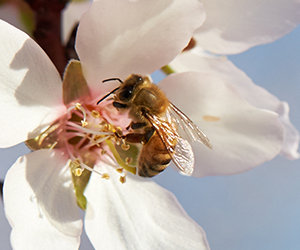Since Publication in 2014, Almond Growers Have Widely Adopted BMPs to Protect Honey Bee Health
 Research published in the journal Insects confirms a key recommendation, and widely adopted farming practice, from the Almond Board of California’s Honey Bee Best Management Practices (BMPs). Designed to protect honey bee health, the Honey Bee BMPs are a set of guidelines for all pollination stakeholders to ensure almond orchards remain a safe and welcoming place for honey bees while balancing the need to protect the developing crop.
Research published in the journal Insects confirms a key recommendation, and widely adopted farming practice, from the Almond Board of California’s Honey Bee Best Management Practices (BMPs). Designed to protect honey bee health, the Honey Bee BMPs are a set of guidelines for all pollination stakeholders to ensure almond orchards remain a safe and welcoming place for honey bees while balancing the need to protect the developing crop.
With support from the Almond Board, study author and Ohio State University researcher Reed Johnson investigated the cause of reported hive losses in the spring of 2014, focusing on the interaction of pest control materials applied in almonds and bee health.
“Honey bees are essential to almond production,” said Bob Curtis, pollination consultant and retired director of Agricultural Affairs for the Almond Board of California. “Every almond we eat exists because a honey bee pollinated an almond blossom so it’s in farmers best interest to keep them safe. Our livelihood depends on it.”
The newly published Ohio State research validates the practice of avoiding insecticide application during bloom, something the Honey Bee BMPs also recommend growers to avoid. The only exception is the application of Bacillus thuringiensis (Bt), which can be applied safely because it is documented to be safe for both adult and immature bees.1 Beyond Bt, alternative treatments and timings outside of bloom are available to growers to target key insect pests.
The University of California Statewide Integrated Pest Management Guidelines for almonds provide insecticide application and timing options at IPM.UCDavis.edu under the Agricultural Pests section. The UC Statewide IPM site also has an interactive tool for determining bee precaution pesticide ratings.
Almond growers have been implementing this safe practice based on publication of the almond BMPs in 2014 and ongoing outreach since then, which is well before the results of this research were published in scientific literature. In fact, according to data gathered from farms assessed through the California Almond Sustainability Program, 97% of almond growers report following all Honey Bee BMP recommendations during almond bloom.2
Widespread change like this does not happen overnight. Upon the BMPs publication in October 2014, Almond Board staff, beekeepers, researchers, and others launched a substantial communications effort including a wide array of presentations to farmers and other pollination stakeholders.
The California almond community has funded more honey bee health research than any other crop group.2 Since honey bee health was made a strategic research priority of the Almond Board of California in 1995, the California almond community has supported 120 research projects to address the five major factors impacting honey bee health — varroa mites, pest and disease management, genetic diversity, pesticide exposure and balancing the need to protect both bees and the almond crop, and access to forage and nutrition. Seven new bee research studies were funded in 2018 with a commitment of $579,000 to improving honey bee health.
Given their essential role in pollination, almond farmers have a deep, vested interest in protecting honey bee health. The bees benefit from this partnership too. Just like almonds are a nutritious snack for us, almond pollen is very nutritious for honey bees, providing all 10 of the essential amino acids their diets require. Bee hives are routinely stronger after visiting almond orchards during bloom.3
Check out Almonds.com/BeeBMPs to read the Honey Bee BMPs and also access the Honey Bee BMP Quick Guide and Honey Bee BMP Quick Guide for Applicators.
[1] Almond Board of California. 2018. Honey Bee Best Management Practices for California Almonds. Almonds.com/BeeBMPs.
[2] California Almond Sustainability Program. August 2018.
[3] Ramesh Sagili. Department of Horticulture, Oregon State University.